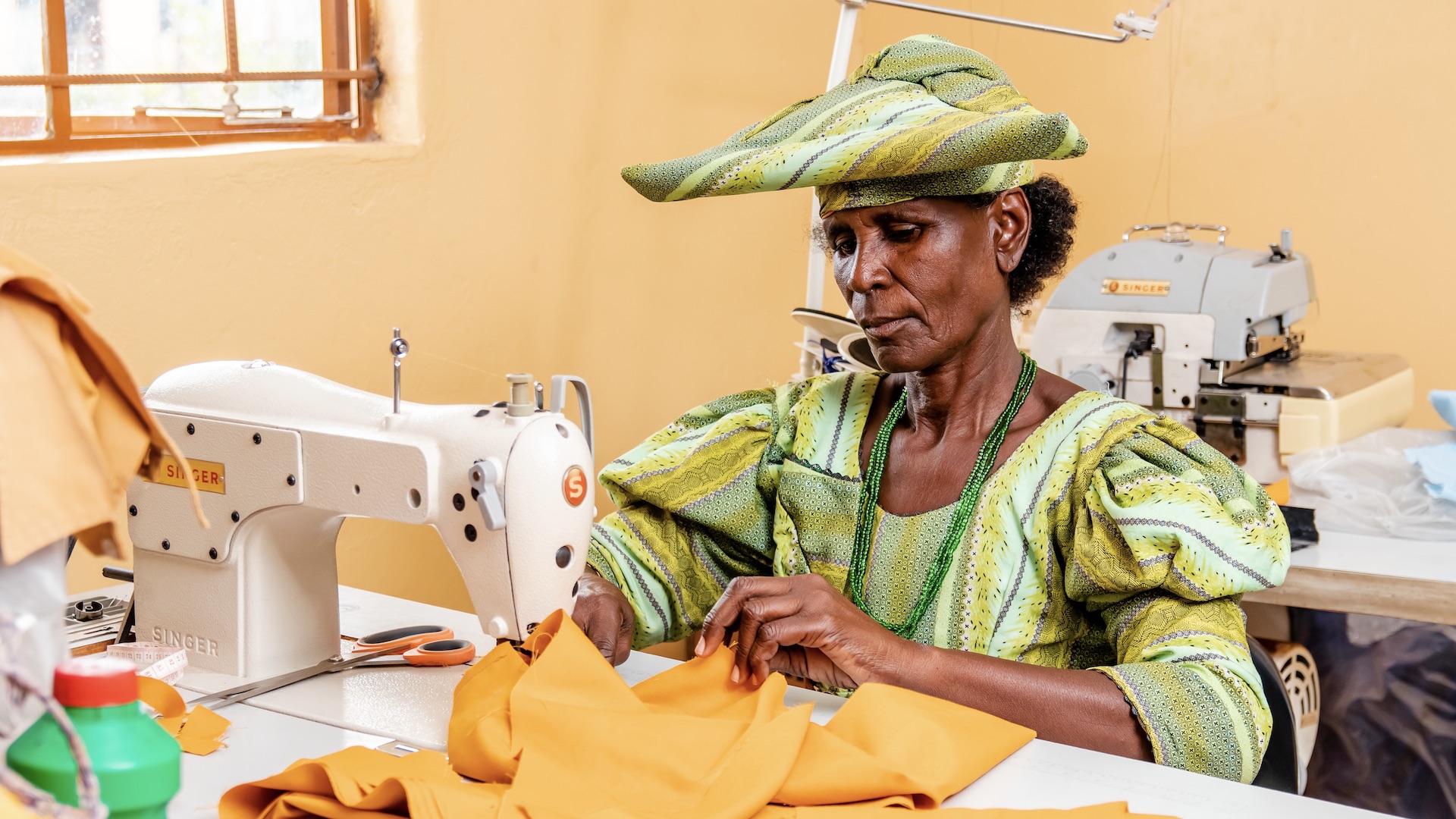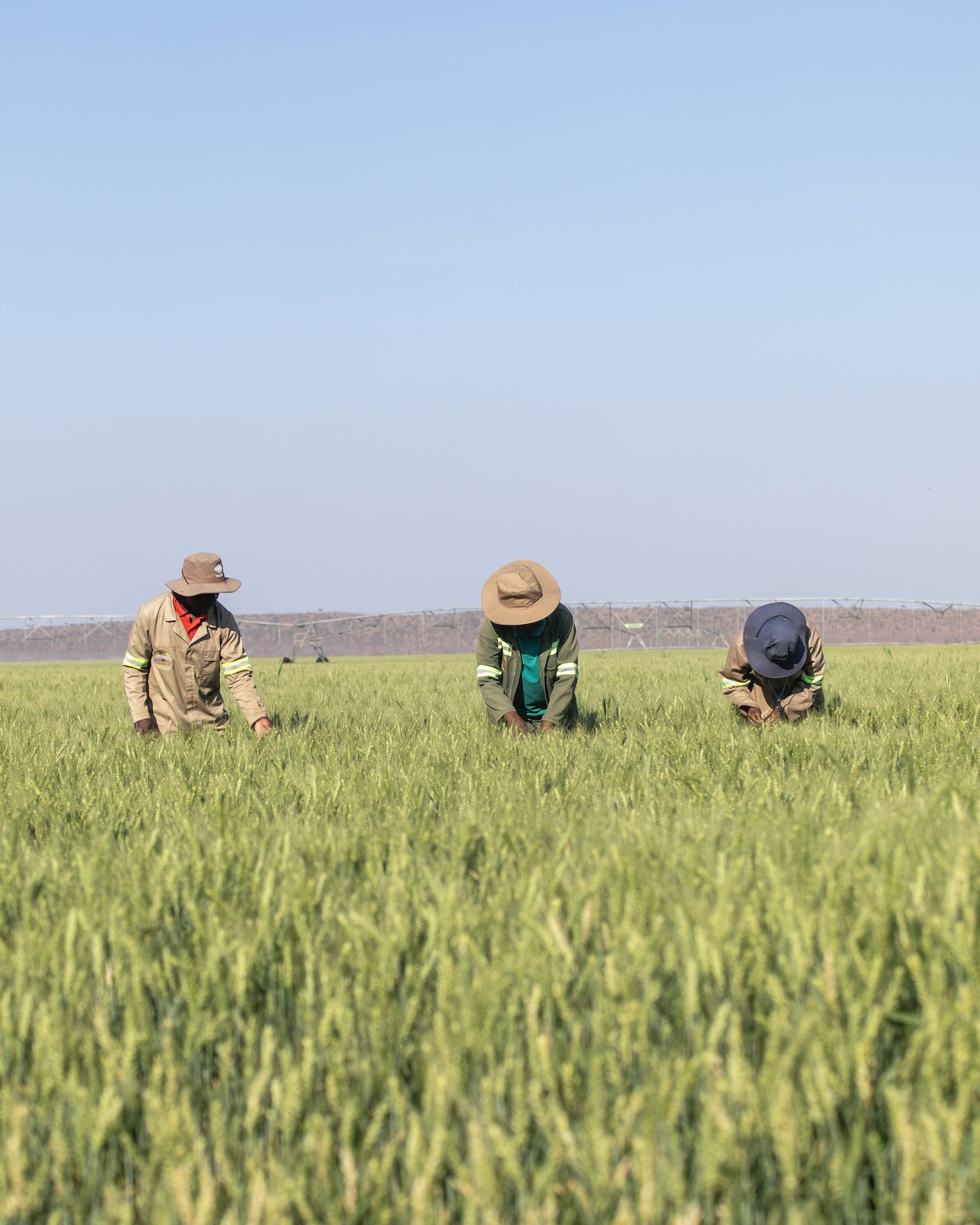The Prosperity Pipeline: Diamonds Fuel Development Dreams
Across Southern Africa and Canada’s Northwest Territories, there’s an empowering narrative of community — one where natural diamonds help build stronger futures through education, healthcare, environmental stewardship, and local economic development

Kwenantle Farms is one of several success stories resulting from the Stanford Seed Transformational program, an initiative supported by De Beers to help local businesses thrive.
In the remote Northern Tuli Block in Eastern Botswana, Lembie Tlhalerwa, co-founder of Kwenantle Farmers, cultivates white maize, sugar beans, and lucerne across sprawling fields. Between managing daily operations and 120 employees, she connects via Zoom with her advisor thousands of miles away in Silicon Valley. This unlikely partnership has helped transform her farming enterprise from a modest 120 hectares to an impressive 1,800 hectares in just a few years, and now she’s embarking on an ambitious export plan.
“I can dream bigger than I ever imagined,” says Tlhalerwa, whose grandparents, like many Botswanans, were subsistence farmers.
Meet the Author

- Jill Newman is a jewelry authority, editor, and storyteller with over 25 years of experience, having reported from diamond mines in Africa, cutting workshops in India and Belgium, and ateliers around the world.
- She serves as Editor-at-Large for the Natural Diamond Council, with additional bylines in The New York Times, Town & Country, Elle Décor, and Robb Report.
She’s a long way from Silicon Valley, but bridging the gap is part of the Stanford Seed Transformation Program, a groundbreaking partnership between De Beers Group and Stanford Graduate School of Business. Rather than uprooting entrepreneurs and sending them halfway around the world, the program brings CEOs and Stanford faculty to Africa for an 11-month course. The initiative is designed to help local entrepreneurs like Tlhalerwa scale their businesses, accelerate the region’s economic diversification, and connect with seasoned advisors and interns.
Today, Kwenantle Farmers is one of the country’s most influential agribusinesses. “Through the Stanford Seed program, I learned as an entrepreneur you need to be able to change your perception of your own business and your mindset to be successful,” she says. “Despite our growing revenue, we still had the mentality of operating a farm. If we kept on the same trajectory, we wouldn’t be here today.”
Lembie is one of over 100 entrepreneurs in Botswana and South Africa who completed the program, and their companies have collectively created more than 3,500 new jobs.
The diamond industry often conjures images of huge enterprises that dominate local economies, but the reality is that a significant portion of rough diamond revenues (80 cents for every dollar worth of diamonds extracted by De Beers) stays within the countries from which the stones were sourced. The profits help fund education, healthcare, and empower small, independent enterprises across Southern Africa. These local businesses form the backbone of their communities, and when they succeed, entire regions prosper.
Over the past decade, diamond companies have accelerated their investments in wide-ranging initiatives outside the mining business, from supporting small farms to recycling work boots to make children’s shoes. The fact is that the diamond mines have a finite lifespan, and companies like De Beers recognize the importance of diversifying the economy to prepare for the future. When you look at the long list of projects, what’s most impressive is how each venture caters to the specific needs of singular communities.
The investment process begins with community engagement, learning what’s needed in the individual provinces, and developing solutions that address concerns where people live. This grassroots approach creates sustainable community development and proves that industry success and local empowerment can work hand in hand.

“At De Beers, we take a partnership-based approach to supporting livelihoods,” says Libbi Lee, the company’s chief sustainability officer. “Every community has unique strengths and challenges, so we focus on holistic initiatives that respond to local priorities. Our goal is to build long-term solutions by strengthening local capacity, developing suppliers, and helping small businesses and entrepreneurs grow through mentoring, networking, and training.”
“In this way, the benefits of diamonds are felt directly in communities, helping them become stronger, more resilient, and able to thrive well beyond the life of a mine,” says Lee.
These initiatives are also looking ahead, creating jobs for a future when the mines are depleted. “Today, for every job we create at our operations, we help support the equivalent of more than two jobs offsite, and by 2030, our ambition is to grow that to four,” says Lee. The group has more than 20 livelihood partnerships and recently launched the Diamonds for Development Fund, designed to accelerate economic diversification and strengthen livelihoods across Botswana for the next decade and beyond.
At a time when greenwashing abounds, it can be hard to separate fact from fiction, but the facts tell a story of how mining companies are reinvesting profits in the countries in which they operate through creative and personalized programs. Here’s a look at the diamond industry’s impact in Botswana, South Africa, Namibia, and Canada’s Northwest Territories (NWT).
By The Numbers:
$1.74 billion spent in 2024 by De Beers Group on goods and services from local suppliers in the countries where it sources diamonds.
3,400 new jobs created across Southern Africa since 2018 outside of the diamond industry through the De Beers-enabled Stanford Seed program, which offers training and mentoring.
377,000 acres restored and managed for conservation in Southern Africa, currently by De Beers, which is equivalent to protecting two acres for conservation for every one acre it mines.
Community Empowerment in Botswana: Diamonds Driving Development

In the past 50 years, Botswana, the world’s second-largest diamond producer, has emerged as Africa’s great success story. The country’s prosperity is the result of an extraordinary partnership between De Beers Group and the Botswana government, a collaboration that has created one of the world’s most responsible and equitable mining industries.
The strategic alliance ensures that diamond profits directly fuel the nation’s development, with revenues going to fund education, healthcare, infrastructure, and skills training programs. The impact is substantial: the diamond industry’s annual revenue now comprises 25 percent of Botswana’s GDP, according to a report by Natural Diamond Council, demonstrating how natural resources can become a foundation for prosperity.
Over the past decade, De Beers has worked closely with government, local stakeholders, and outside agencies to help diversify the nation’s economic dependence on diamonds and create more opportunities, particularly for those underrepresented in the workforce, including women and youth.
One groundbreaking initiative is the De Beers-backed Tokafala program. What began a decade ago to help small local businesses thrive and facilitate economic diversification has cultivated more than 12,000 jobs outside mining, and more than 50 percent of the businesses are female-led.
Ogona Simon, a former stay-at-home mother, is an example of how Tokafala is changing lives. “I received training in financial literacy, record keeping, developing a business model, writing a business plan, and other valuable skills,” says Simon, who founded the Tuition Center, which provides remedial education services. Her start-up allowed her to afford her own home and her children’s school tuition.
It’s small initiatives like these, which train and mentor single-owner enterprises, that are empowering women and delivering independence. It’s not just single-owner business benefiting, but there is a spirit of paying it forward, says Simon, who is passing on her knowledge to other women in the community.
In the remote Mokubilo village, the Lucara Diamond company helped establish an integrated farm in 2019 to improve the nutritional well-being and economic stability of the community. Today, the female-led workforce supplies its community, neighboring villages, and supermarkets with a variety of vegetables and eggs. It’s just one of 19 villages where Lucara supports training women with skills to earn money and improve their quality of life.
In another ongoing venture, De Beers Group has contributed $8 million to date and helped over 3,000 women across southern Africa access transformative business support through a partnership with UN Women and local governments called EntreprenHER. Established in 2017, the program is designed to help female micro-entrepreneurs access funding, business training, networking and mentoring support, and learn essential skills in areas such as accounting and leadership.
It’s not just about startups. De Beers is also helping established businesses in sustainability and technology accelerate their growth through the Trailblazer Accelerator in partnership with WomHub. It’s another way the diamond giant is championing local businesses and economic diversification.
By The Numbers:
$1.8 billion revenue generated in 2024 from Debswana Diamond Company’s sales (a 50/50 joint venture between the Botswana government and De Beers Group). Figures from a report published by Natural Diamond Council.
80 cents of every dollar generated from Debswana’s diamond extraction is reinvested in the country annually.
$1 billion annual sales turnover of Okavango Diamond Company (ODC), a state-owned enterprise, according to a report by Natural Diamond Council.
89,856 children attended free secondary school in 2022 in Botswana compared to just 100 in 1966, according to a report from Natural Diamond Council.
More than 2,000 girls have participated in Debswana STEM Girls Program.
How South Africa’s Diamonds Are Redefining Local Enterprise

In South Africa, diamond sales generated $731 million for the economy in 2024, according to South Africa’s Minister of Mineral and Petroleum. Beyond the mines, De Beers has launched several initiatives designed to train and support small businesses and create job opportunities. One of the country’s many inspiring enterprises is Taking Care of Business (TCB), founded by Tracy Gilmore, COO, and Tracey Chambers, CEO, in Cape Town in 2010. TCB takes discarded and overstock fashion, appliances, homeware, and fabric, which are then repaired and sold through a network of more than 2,000 traders and small business owners annually.
The business simultaneously reduces waste (it processes over 2 million items annually) and creates self-employment opportunities.
“My passion is finding opportunities for unemployed South Africans,” says Gilmore. But it wasn’t until she participated in the De Beers-powered Stanford Seed program that she was able to broaden the business and grow at “leaps and bounds,” she says. “Since Stanford Seed, we have expanded our reach and are supporting thousands of micro-entrepreneurs and generating millions in revenue.”
While TCB teaches South Africans to sew and mend clothing and fix appliances, it also educates them in finance and life skills to help their businesses thrive. “Once they have a skill, no one can take it away from them,” Gilmore says.

Among the participants was Ntokozo Alicia Dlomo, who was raised in a family of eight and struggled to find work to support her own children. After TCB training, she started selling clothing in her community. “I never thought I’d be a business owner, but with TCB’s support, I was able to turn my life around,” she says. “The skills I gained–business management, money management, and entrepreneurship–were transformative. I learned how to be my own boss, how to make smart financial decisions, and how to manage my business effectively.”
In another area of South Africa, where Petra Diamond operates the Cullinan and Finsch mines, the community is thriving thanks to the company’s creative philanthropy and partnerships. A wide range of initiatives encourage the locals to participate in recycling programs to reduce waste and earn income.
Projects include recycling the mine workers’ boots to make shoes for the Leeuwfontein Primary Farm School. In the Finch region, it established Litter4Tokens, where locals can exchange their recyclables for a Petra recycling coin, which can be used as currency at local retailers. In the first six months, over 8,000 tokens were issued. The mining company also supports the local Sizanani Children’s Home for young adults and children with disabilities through donations of essential wheelchairs, therapeutic mats, blankets, and more.
By The Numbers:
$731 million in diamond sales generated for South Africa’s economy in 2024, according to South Africa’s Minister of Mineral and Petroleum.
$4.7 billion in South Africa’s diamond exports in 2023.
$19.1 million paid in taxes and royalties in South Africa in 2024 by Petra.
$67 million paid in taxes and royalties in South Africa in 2023 by De Beers.
$847 million paid in taxes and economic contribution combined in 2023 by De Beers.
How Namibia’s Diamond Community Helps to Empower Women
In Namibia, the country’s mining company Debmarine is an equal partnership between De Beers and Namibia’s government, and 80 cents of every dollar earned stays within the country. As the country’s largest taxpayer, Debmarine contributed $545 million to the economy in 2024, according to an Anglo American report. The profits permeate everything from education and healthcare to infrastructure and training. In addition to numerous environmental initiatives, the mining company is focused on helping women attain career skills, income, and independence.
At the cornerstone of this goal is EntreprenHER, the program powered by De Beers Group, UN Women and local government that is supporting women with the skills to run their own businesses. One example is Elise Iilhuwa, who began creating and selling organic indigenous food in her Katutura neighborhood out of necessity when she learned she had dangerously high blood pressure and glucose levels and needed to change her diet. In 2016, she established the Namashisha Investments business to market her products, but it wasn’t until she attended EntreprenHER that her business flourished.
“I learned budget, price my products, and market them,” she says. Now she’s distributing to other African nations and helping support Namibian women start-ups. With her newfound income, she can support her three children and a soup kitchen that feeds local children. “I’m also helping educate Namibians on healthy eating.”
By The Numbers:
$1.09 billion value of Namibia’s diamond exports in 2022.
80 cents of every dollar generated by NAMDEB Diamond Corp. (a 50/50 partnership with the Namibian government and De Beers Group) stays in the country.
20% of Namibia’s export earnings are diamonds annually, according to a report by the Natural Diamond Council.
Community Strength in the North: The Diamond Industry’s Lasting Impact

In far Northern Canada, diamonds are mined in Arctic tundra where indigenous peoples have lived for thousands of years. From the beginning, De Beers and Rio Tinto have embraced the region’s local community and culture, ensuring they prosper alongside the diamond industry. The Canadian Northwest Territories’ diamond mining industry has generated $21.8 billion and $8 billion went to indigenous-owned businesses, according to a report published by Natural Diamond Council and based on data from the Government of the Northwest Territories.
At the core of the diamond company’s investments is education and training. Rio Tinto offers residents of the NWT scholarships and funds youth education with a focus on preserving Indigenous culture.
Among the key achievements supporting and improving regional life is the Tibbitt-Contwoyto Winter Road, which is critical to the operation of the Ekati, Diavik and Gahcho Kue diamond mines. The three mines financially support the road and majority operated Indigenous companies—Tłı̨chǫ Investment Corp., Denesoline Corp., Nuna Logistics, and Det’on Cho—helped construct the road and ensure its security year-round. It doesn’t just support the mine’s work, but it benefits the local and Indigenous people, cutting down their travel time to cultural areas and hunting grounds, and giving them more time with family.
The numbers speak for themselves: diamond companies are investing considerable sums in the countries where they operate. But it’s more than a story of dollars and figures, it’s about partnering with local communities, engaging with women and youth, and tackling the hardest issues with salient solutions that are transforming lives.
By The Numbers:
$21.8 billion revenue from NWT’s diamond mining has contributed to the economy since 1996.
$15.2 billion went toward NWT businesses since 1996.
$610 million went to NWT businesses in 2023 alone.
28% the amount diamonds contributed to the GDP in 2022.
70,000 books provided to youth in Indigenous communities.











